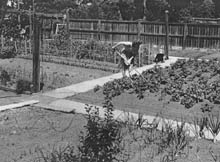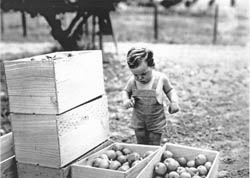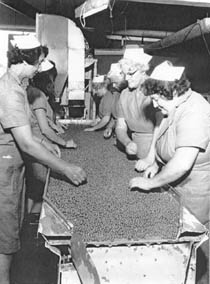| |
 Fresh,
Canned, Frozen: Fruit and Vegetables Fresh,
Canned, Frozen: Fruit and Vegetables
|
A house and garden
on a patch of land have formed part of the 'New Zealand dream' for most
of the twentieth century. In that vision, the garden has been both utilitarian
and decorative: vegetables out the back in the fenced-in, private area,
and flowers and other blooms out the front on open, public display. The
tasks of maintaining those separate gardens have often been gender-specific.
The 'vege garden' belonged to the man of the house, while women tended
the prettier flower sections. 
In practice, women
have maintained both front and back yards, particularly during the 1940s
and 1950s when home gardens for functional uses were at their most popular.
Gardens have
changed since mid century, and the large vegetable garden is no longer
a prominent feature of New Zealand life.
In its heyday, however,
a vibrant vegetable garden was a  sign
of a healthy, hard-working family that had an eye on thrift as well as
the task of building a home�with all the values that term entailed. In
popular memory at least, many urban and rural households were self-sufficient
in fruit and vegetables, or could at least obtain supplies of fresh produce
from market gardens and orchards. While market gardens grew a range
of vegetables, large-scale orchard production has focused on apples as
a major crop for export as well as local consumption. sign
of a healthy, hard-working family that had an eye on thrift as well as
the task of building a home�with all the values that term entailed. In
popular memory at least, many urban and rural households were self-sufficient
in fruit and vegetables, or could at least obtain supplies of fresh produce
from market gardens and orchards. While market gardens grew a range
of vegetables, large-scale orchard production has focused on apples as
a major crop for export as well as local consumption.
 Housewives
were expected to be well-versed in all methods of cooking and preserving
fruit and vegetables. Recipe books included extensive sections on bottling
and other forms of preserving, in addition to using those products in
a range of puddings, cakes or condiments; New Zealanders had an 'obsession
with bottling' in the mid twentieth century. Aunt Daisy's 1954 recipe
for beetroot chutney, for example, relied on housewives having a knowledge
of making chutneys and conserves, and preserving fruit and vegetables.
She provides the barest of methods in her recipe, giving no advice on
how to preserve the chutney. Housewives
were expected to be well-versed in all methods of cooking and preserving
fruit and vegetables. Recipe books included extensive sections on bottling
and other forms of preserving, in addition to using those products in
a range of puddings, cakes or condiments; New Zealanders had an 'obsession
with bottling' in the mid twentieth century. Aunt Daisy's 1954 recipe
for beetroot chutney, for example, relied on housewives having a knowledge
of making chutneys and conserves, and preserving fruit and vegetables.
She provides the barest of methods in her recipe, giving no advice on
how to preserve the chutney.
Beetroot
Chutney
Three
pounds beetroot, 1 1/2 lb. apples, 2 onions, 1 pint vinegar, 1/2 teaspoon
ginger, 1 teaspoon salt, juice of 1 lemon, 3/4 lb sugar. Boil the beetroot
until tender; cut into cubes when cold. Cut onions and apples small and
boil with the vinegar, sugar etc. Add the prepared beetroot and boil another
1/4 hour.
(From Aunt
Daisy's Favourite Cookery Book, 3rd edn, Whitcombe and Tombs, Christchurch,
1954, p.356.)
Despite
the emphasis on fresh produce, whether home- or  orchard-grown
or store-bought, New Zealand has long produced processed fruit and vegetables.
By the early 1890s, canning plants were producing jam and processing other
forms of fruit, and canned peas were being sold by the beginning of the
twentieth century. Frozen vegetables came later, including the enduringly
popular frozen pea, which is shown being sorted at Dobson's Frozen Food
in Marlborough in 1948. orchard-grown
or store-bought, New Zealand has long produced processed fruit and vegetables.
By the early 1890s, canning plants were producing jam and processing other
forms of fruit, and canned peas were being sold by the beginning of the
twentieth century. Frozen vegetables came later, including the enduringly
popular frozen pea, which is shown being sorted at Dobson's Frozen Food
in Marlborough in 1948.
Frosted Foodstuffs
were operating in Auckland  by
the mid 1940s; they were followed by Lever Brothers and J. Wattie canneries
in the 1950s. Watties has been a major manufacturer of canned goods ranging
from baked beans and spaghetti (canned forms of which were all that was
available before the 1930s) to fruit salad, such as this item being selected
at a Woolworths Supermarket in 1964. by
the mid 1940s; they were followed by Lever Brothers and J. Wattie canneries
in the 1950s. Watties has been a major manufacturer of canned goods ranging
from baked beans and spaghetti (canned forms of which were all that was
available before the 1930s) to fruit salad, such as this item being selected
at a Woolworths Supermarket in 1964.
|
|
Hear
Aunt Daisy give her beetroot chutney recipe in this recording from
a February 1950, ZB morning show.
Intro
(280k)
Chutney recipe (678k)
Whole Show (10min - 1.2mb)
More
Aunt Daisy:
Cornflour Blancmange recipe (523k)
Sound
recordings provided by Sound
Archives/Nga Taonga Korero, Copyright Radio New Zealand. Ref:
TX2858 and DCDR36.
You
will need Real Player to play the sound clips. (This is a free download
as long as you choose Realplayer and not Realplayer plus.)

Biographies
of James Wattie and Maud Basham (Aunt Daisy) are available on the
online Dictionary of NZ Biography
website |
|
![]() Gallery
Gallery
![]() Food and drink
Food and drink